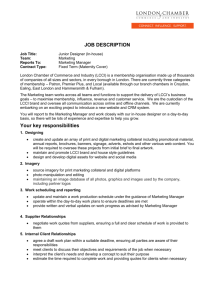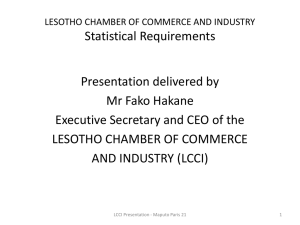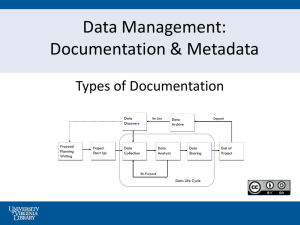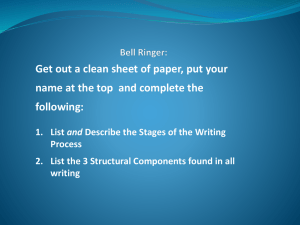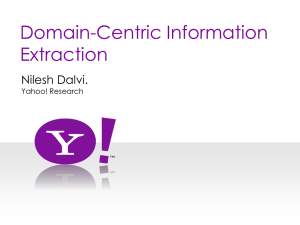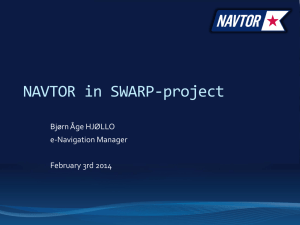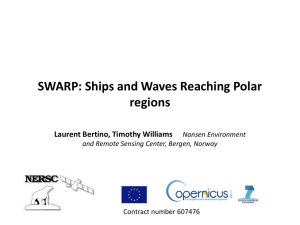ppt - unedf
advertisement
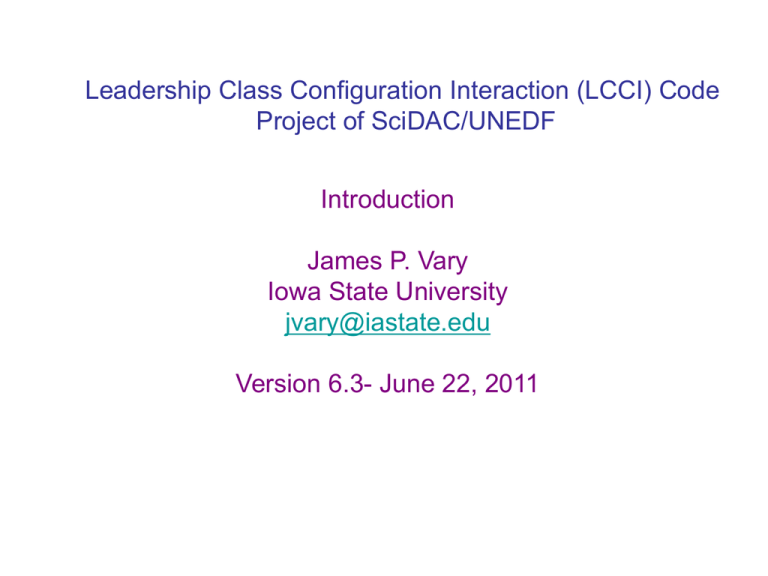
Leadership Class Configuration Interaction (LCCI) Code Project of SciDAC/UNEDF Introduction James P. Vary Iowa State University jvary@iastate.edu Version 6.3- June 22, 2011 LCCI LCCI Project Background Official LCCI project launch - June 2009 Face-to-face meetings held twice annually - next meeting scheduled for APS Annual Meeting, May 2011 Meetings are open to UNEDF members and invited guests. Summary of 6 meetings to date and links to the white paper, “CI-Solver Task Force draft planning document”, at www.unedf.org/users/projects/lcci.php [Note UNEDF username and password required] LCCI Environment - Overview Ab initio Interactions Model space Hamiltonian 2-body, 3-body Conventional Interactions Many-body eigensolver Post-processing Eigenfunctions, Observables, etc Features/properties: Scalable 1-106 cores Update Data Base Goal: LCCI code should solve, at least, the identified consensus structure problems from “extreme scale” white paper LCCI codes/scripts deposited initially on Oct. 2-4, 2009 Codes/Scripts BIGSTICK MFDn NuShellX trdens ncsmv2eff LCCI-wrapper Contact Calvin Johnson Pieter Maris Mihai Horoi Petr Navratil Petr Navratil Maris/Johnson email cjohnson@sciences.sdsu.edu pmaris@iastate.edu horoi@phy.cmich.edu navratil@triumf.ca navratil@triumf.ca pmaris@iastate.edu Updated June 2011 June 2011 March 2011 April 2010 March 2010 July 2011 Final update Nov 2011 Nov 2011 Nov 2011 Nov 2011 Nov 2011 Nov 2011 Source codes for each resides in its own subdirectory in NERSC project space: /project/projectdirs/unedf/lcci with a README file, one or more scripts, and test cases. In addition, this introduction and an introduction to the DBMS reside there and are updated as major developments warrant. Consensus at Hawaii meeting, October 2009 Policies and procedures for revisions Revisions can be deposited at any time with a suitable revision label on the newly created subdirectory Previous versions should not be deleted from the project space. Owners of codes need to retain their originals in a safe place as the codes deposited at NERSC in project space are not backed up. The following statements are from the NERSC web pages: “Files in global homes are not subject to purging. However, they are also not backed up, except for disaster recovery of the entire filesystem. That is, individual files and/or directories can not be restored from the disaster recovery backups.” Following slides portray code interoperability and current flowcharts Trel Hcm Vcoul JISP16 Option: Lee-Suzuki renorm V-phenomenological Ab initio NCSM Flowcharts Heff Hjorth-Jensen Codes Transform from relative to HO or WS single-particle basis M2 Idaho-N3LO Idaho A/B, . . . Vlowk, SRG GOSC Reformat Library/ Build H Transform from relative to HO single-particle basis MFDn/ BIGSTICK V3TRANS NN + NNN MANYEFF NCSMV2EFF Idaho-N3LO AV18 AV8’ AV6 AV4 Local N2LO NNN CD-Bonn Epelbaum N3LO Idaho-N3LO TM’ NNN INOY Option: Lee-Suzuki or SRG renorm TRDENS Data Base Matrix elements for reactions a+a a+a+aa a+ a+a+ a+a+a+ a+a+a+a+ RGM/Reactions New and planned additions to this “LCCI Introduction” ppt file: One slide per major code directing to README file for additional details * * * * * See following slides * * * * * We plan to expand to one slide per “upstream code” directing to README file or code’s author for further info. Upstream codes Heff, M2, GOSC MANYEFF, V3TRANS, NCSMV2EFF* Contact person James Vary (jvary@iastate.edu) Petr Navratil (navratil1@llnl.gov) *Note that an initial version of NCSMV2EFF is available at /project/projectdirs/unedf/lcci/ncsmv2eff *************** Following the code-specific slides, we include the consensus goals from the nuclear physics extreme scale computing workshop report available at: http://extremecomputing.labworks.org/nuclearphysics/report.stm These physics goals serve as guides for the LCCI project development BIGSTICK – a configuration-interaction code: W. E. Ormand, LLNL; C. W. Johnson, SDSU; P. G. Krastev, SDSU •Purpose: Solve the general many-fermion problem. •Method: Lanczos algorithm to find low-lying eigensolutions of large Hamiltonian matrix; on-the-fly matrix-vector multiply using factorization. •Input: General single-fermion basis, assuming good angular momentum j. User-friendly interactive input. • Two “species” of particles, e.g. proton/neutron (half-integer j) or spin up/down (integer j); allows general radial wavefunctions. • Flexible truncation of many-body basis covering many common choices. • General two-body interactions, assuming only rotational invariance, read in as files of precomputed matrix elements; can read in different formats and multiple files. • Can assume or break isospin symmetry. • General three-body interactions • • Output: Produces output wavefunctions compatible with TRDENS. Option to automatically compute one-body transitions densities without further postprocessing. • Implementation: M-scheme many-body basis; states of good J automatically recovered. • •Works well both on serial machines and with MPI parallelization. •Hybrid MPI/OpenMP parallelization. For more info see README file at: /project/projectdirs/unedf/lcci/BIGSTICK NuShellX – a configuration-interaction code: B. A. Brown, E. McDonald, M. Horoi, W. D. M. Rae •Purpose: Solve the general many-fermion problem. •Method: Lanczos algorithm to find low-lying eigensolutions of large Hamiltonian matrix; on-the-fly matrix-vector multiply. •Input: General single-fermion basis, assuming good angular momentum j. User-friendly interactive input. • Two “species” of particles, e.g. proton/neutron • Flexible truncation of many-body basis covering many common choices. • General two-body interactions, assuming only rotational invariance, read in as files of precomputed matrix elements; can read in different formats and multiple files. • Can assume or break isospin symmetry. • Output: Produces wavefunctions, spectroscopic factors, one-body transition densities • • Implementation: J-scheme many-body basis •Works well both on serial machines and with OpenMP parallelization. •Hybrid MPI/OpenMP parallelization (completed/testing in prgress). •Wrapper codes for Table of Isotopes and Hamiltonians For more info see README file at: /project/projectdirs/unedf/lcci/nushellx MFDn - Many Fermion Dynamics - nuclear A configuration interaction code • General-purpose and portable many-fermion code; solves very large matrix Hamiltonian in a Slater determinant basis • Uses general single-fermion basis, assuming good angular momentum j. • One or two “species” of particles, e.g. proton/neutron (half-integer j); allows general radial wavefunctions • Flexible truncation of many-body basis covering several common choices. • General two-body and three-body interactions, assuming only rotational invariance; read in as files of precomputed matrix elements; can read in different formats; reads in and independently scales multiple interaction files • Option to run with an external field • M-scheme many-body basis; states of good J automatically recovered. • Lanczos eigensolver using full many-body matrix stored in core. • Works both on serial machines and with MPI/OpenMP parallelization • Produces output wavefunctions compatible with TRDENS • Option to automatically compute one-body transition densities without further post-processing • Options to evaluate various suites of observables For more info see README file at: • Total J version (in progress) /project/projectdirs/unedf/lcci/MFDn MFDn - v13n n For more info see README file at: /project/projectdirs/unedf/lcci/trdens Overview of Iowa State “upstream” codes Further information: James Vary (jvary@iastate.edu) Heff Generates two-body matrix elements of an NN interaction in the relative coordinate harmonic oscillator basis. Includes capability to unitarily transform from one harmonic oscillator basis to another. Contains the option to perform the Lee-Suzuki renormalization transformation. M2 Transforms two-body matrix elements from the relative coordinate harmonic oscillator basis to the harmonic oscillator single particle basis (Talmi-Moshinsky Transformation). Also contains the option to transform to the Woods-Saxon single particle basis by a finite expansion in an underlying harmonic oscillator basis. Options include capability of generating Trel, Vcoul, etc matrix elements in the chosen single particle basis. Option to generate Minnesota and other interactions. GOSC Transforms output files from M2 (matrix elements grouped by [J,T,Parity]) to one of the input formats used by MFDn (e.g. matrix elements grouped by [a,b,c,d]). The output format of GOSC is specified by the parameter “IPOTENTIAL” within the code. LCCI Wrapper Goal: Single LCCI wrapper to access all LCCI resources Initial working wrappers - BIGSTICK, MFDn, NuShellX LCCI python wrapper development stages Intermediate - BIGSTICK/MFDn (Year 4) Final - BIGSTICK/MFDn/NuShellX (Year 5) MFDn: - sets up a run for Franklin or Hopper using an available 2- or 3-body interaction files - Python script generates a batchscript to be submitted to batch queue - successful run produces output suitable for inclusion in LCCI database BIGSTICK: - menu driven input already, user friendly - template input files available - template batchscript for submission to batch queue available Leadership Class Configuration Interaction (LCCI) Environment: ab initio computational nuclear physics resources for the future SciDAC/UNEDF initiative to unify, preserve and disseminate valuable CI codes & resources User-friendly environment for researchers to download and run state-of-the-art CI codes Archives results (e.g. wavefunctions, densities,…) from large-scale production runs Aims to enable CI calculations planned for extreme-scale computers and archive the results Policy statement on LCCI data release Adopted at LCCI-2010, March 13, 2010 Nuclear structure spectra, wavefunctions and quantities derived from them, such as one-body density matrices, often represent substantial investments of resources. Once a group has completed a publication based on their nuclear structure wavefunctions, one-body densities, etc., they are strongly encouraged to deposit those data, with suitable provenance information in the LCCI database. Suitable provenance information includes identifying codes, input data, scripts, compilers, hardware, etc. employed, as well as relevant publications, so that an expert researcher could reproduce the data. Policy statement on LCCI data access Adopted at LCCI-2010, March 13, 2010 Nuclear structure spectra, wavefunctions and quantities derived from them, such as one-body density matrices, often represent substantial investments of resources. Data deposited in the LCCI data base are available to all users of the system (currently NERSC). Access is granted by the group generating that data with the understanding that users will cite the relevant publications presenting the science and technology underpinning that data and will cite the LCCI database. A Database Management System for LCCI Ritu Mundhe, Fang Liu, Masha Sosonkina Ames Laboratory Miles V. Aronnax, Iowa State See introduction in separate file: Database_Mgmt_System_v1.pdf LCCI Year 4 deliverables First 4 bullets are periodically updated items LCCI codes/scripts delivered to UNEDF & updated Design/Prototype Data Base Management System (DBMS) Design/Prototype unified wrapper - MFDn/Bigstick versions Developed NuShellX wrapper Hands-On LCCI tutorials - after Brad Sherrill’s talk LCCI Year 5 roadmap Complete a unified LCCI wrapper (ISU/MSU/SDSU) Complete prototype LCCI Data Base Management System (DBMS) Final versions of UNEDF LCCI codes/scripts delivered to UNEDF 2011 LCCI Meeting Lawrence Berkeley National Laboratory March 17-19, 2011 Host: Esmond Ng Program and Attendance of Lithium Isotopes Also attending: Metin Aktulga LCCI Meeting March 17-19, 2011 Issues discussed: Progress on code & script developments Update schedules (slide 5) Modifications to Year 5 goals, deliverables (slide 25) What to propose for SciDAC-3 Some specific questions discussed: LCCI thrust areas to propose for SciDAC3: double beta decay (slides 16, 18) ab-initio nuclear reactions (slides 16, 19) structure of medium mass nuclei: 78Ni, 132Sn (slides 16, 19) If/how to fold the upstream codes into wrapper -> SciDAC3 Will additional researchers deposit .info files to DBMS -> Yes Desired features for DBMS/Workflow and their priorities -> Ongoing What happens to UNEDF web site & m308 at end of UNEDF? -> UNEDF Council to address Making the LCCI repository public, e.g. via UNEDF web site, or via FRIB or via NNDC -> possibly all 3 Outcomes reflected in updated version of LCCI Introduction available for downloading from NERSC: /project/projectdirs/unedf/lcci/LCCI_Introduction_v6.3.pdf
